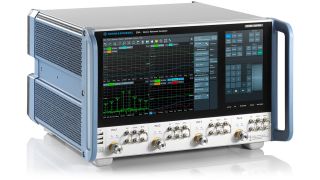Similarly, the performance of high-power 300 W circulators in the Ku and Ka (downlink) bands critically depends on the local temperature in the ferrite. It is also difficult to reliably predict this temperature by analysis.
Until now, it was not possible to test these devices at high power to reveal their true frequency response since they would normally be fed with a travelling wave tube amplifier (TWTA), which is not suitable for fast switching between frequencies. Instead, they are typically tested at low power levels with a vector network analyzer, and the OMUX or circulator is heated up to a calculated effective temperature to simulate the effects of power dissipationwithin the device.
The problem with this method is that it is difficult to calculate an effective homogeneous temperature, particularly for temperature-compensated OMUX channel filters and circulators. In the real application, heat is not dissipated evenly throughout the device. Hotspots are created at points where more power is dissipated within the structure, which affects the electrical behavior in a way that is not easy to recreate.







